Bailarinas del Istmo – Female dancers of Tehuantepec in southern Mexico where unique folkloric dress and traditional dances are celebrated. (Image credit: Spanish Academy)
National Hispanic Heritage Month (September 15 – October 15) celebrates the diverse cultures and contributions of Hispanic and Latino Americans, highlighting ancestry from Spain, Mexico, the Caribbean, Central America, and South America.
For many, it is a vibrant celebration of the lasting influence of Hispanic voices in fashion. The richness of Hispanic culture shines through in bold textile weaving, brilliant dyeing traditions, and intricate embroidery that continue to inspire artists and designers alike. This blog is dedicated to honoring that legacy by highlighting the innovation, artistry, and beauty found in traditional textiles and embroidery of Mexico.
Textiles
Traditional Mexican textiles trace back approximately 2,500 years and were made from fibers of the yucca, palm, cotton,willow, and maguey plants. These early textiles are a key part of Mexican culture and the central piece of ancestral civilizations: the Aztecs, Mayans, Olmecs, Toltecs, Teotihuacans, Zapotecs, Mixtecs, Huastecs, Totonacs, and Purépechas, among many others. The approximately 60 ethnic groups each had their own representative Mexican textile patterns, fabric uses, and clothing styles, much like how tartan patterns are traditionally associatedwitha specificScottishclan, region, orfamily and worn as a statementof kinship, pride, andloyalty.
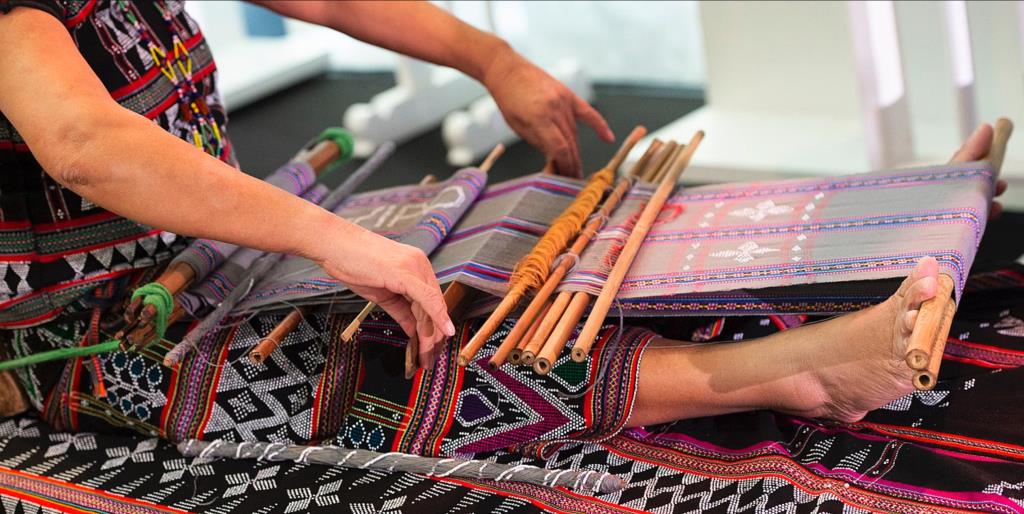
Women using a backstrap loom to weave a traditional Mexican textile. (Image credit: Wiktionary)
The process of weaving traditional clothing in Mexico is typically performed using a backstrap loom, a weaving device where the loom is anchored at one end to a stationary object (like feet, tree or post) and the other end attaches around the weaver’s back with a strap. Treadle looms of Spanish origin are also employed, especially for weaving blankets, ponchos, and other larger items. Traditional garments made from these looms are the huipil, quechquemitl and rebozo.
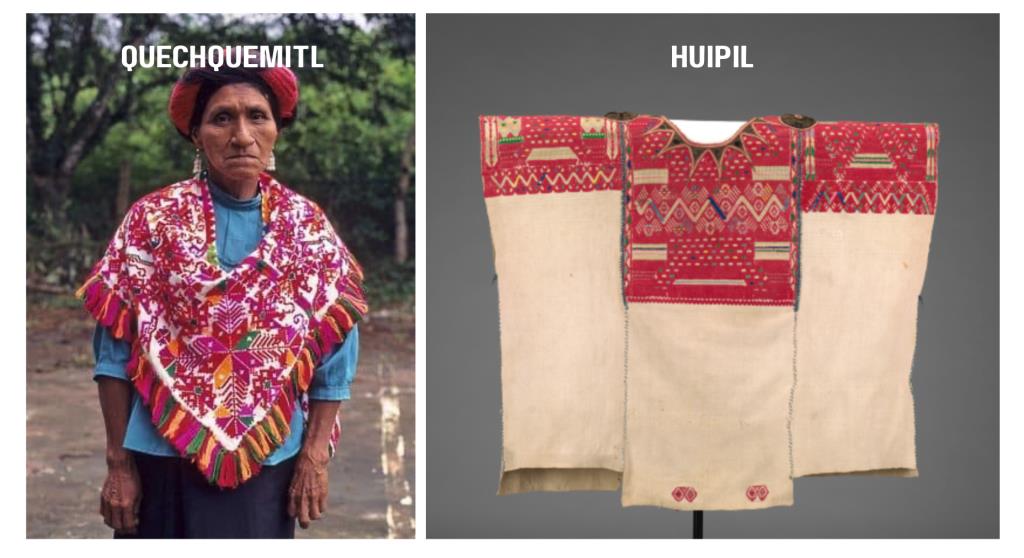
Traditional Mexican garments are made from the backstrap loom and treadle loom. (Image credit: Huexotzinco and The Denver Art Museum).
A quechquemitl (pronounced kehch-keh-MEET-l) is two rectangularpieces of handwoven fabric joinedtogether, forminga V- or diamond-shaped garmentthat drapes overthe shoulders, creating pointed ends in frontand back.
A huipil (pronounced wee-peel) is a loose-fitting cap-sleeve tunic, generally made from two or three rectangular pieces of fabric joined together with stitching, ribbons, or fabric strips, with an opening for the head and arms. Huipiles are mostly made from cotton, although velvet is also used for special occasions particularly in Tehuantepec. The artist Frida Kahlo was famous for wearing both Mexican indigenous garments.
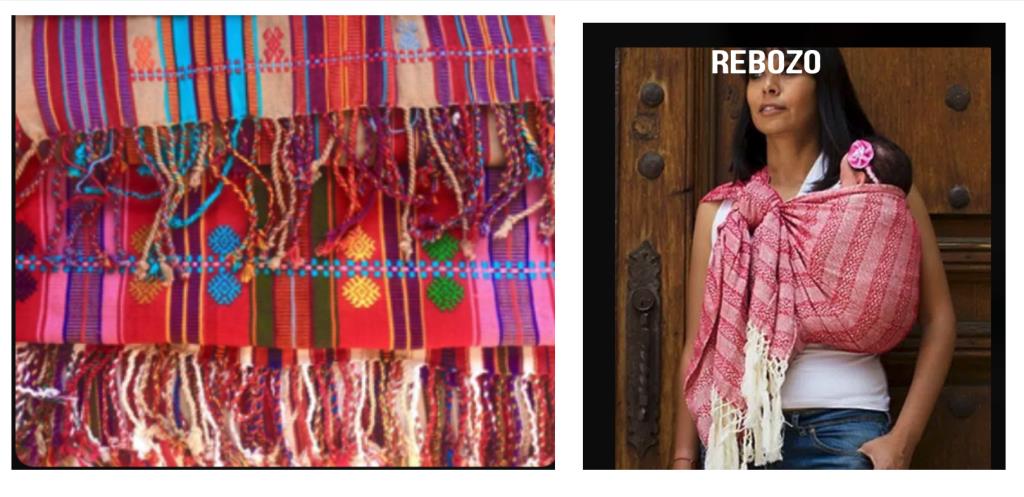
Colorful textile used to make rebozos (Image credit: Mexico1492 and Sacred Window Studies)
A rebozo is a traditional Mexican garment —a long, flat rectangle of woven fabric—worn primarily by women as a shawl, head covering, or wrap. It serves both practical and symbolic purposes, offering warmth, modesty, sun protection, and acting as a secure carrier for babies or bundles, especially among indigenous and mestizo women. Distinctive for its fringed ends (rapacejos) that are often hand-knotted into intricate patterns. It is handwoven from cotton, wool, silk, or rayon, often in ikat patterns, with regional variations in color, pattern, and weaving technique.
Sarape (Serape/Zarape)
Originating from Saltillo, Coahuila, sarapes are brightly colored, striped textiles used as blankets or ponchos that have become symbols of Mexican identity.
Oaxacan Textiles
Traditional Zapotec and Mixtec textiles from Teotitlán del Valle, Oaxaca. (Image credit: Brogan Abroad)
Oaxaca is renowned for a range of textiles featuring intricate embroidery and weaving with motifs often representing nature, mythology, and daily life. The wool used is dyed in vibrant shades of gold, red, green and blue, using natural ingredients like pecans, alfalfa, pomegranate skin, indigo, andcochinilla (cochineal) bugs.
Embroidery
Otomi Embroidery (Tenango)
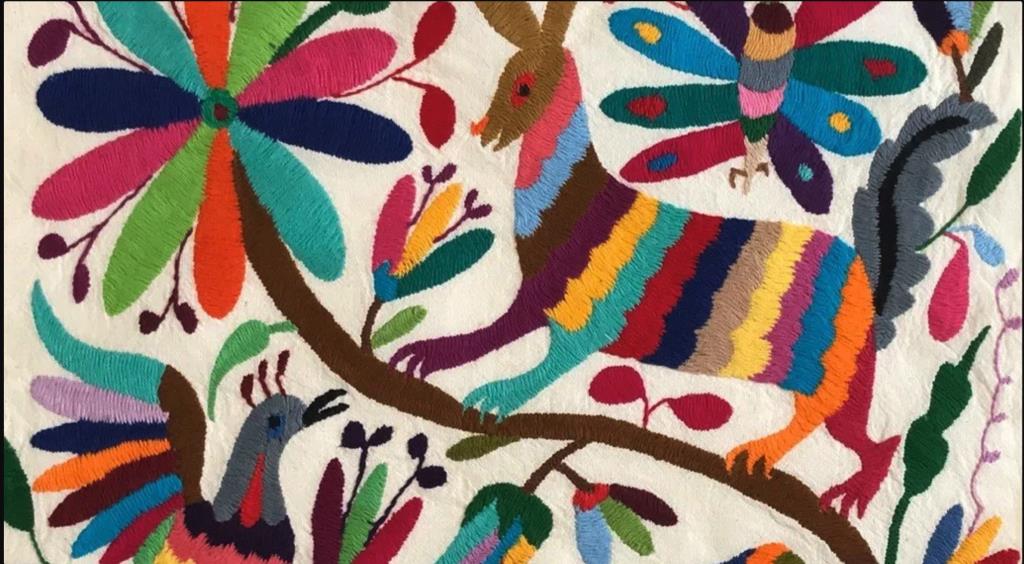
Recognizable by its vibrant, animal and plant-inspired designs, Otomi embroidery is a vibrant Mexican folk art, characterized by handrawn intricate designs and mythological figures stitched in bright colors onto white fabric. It hails from central Mexico, particularly Tenango de Doria in Hidalgo. (Image Credit: OtomiMexico.com)
Oaxaca Embroidery
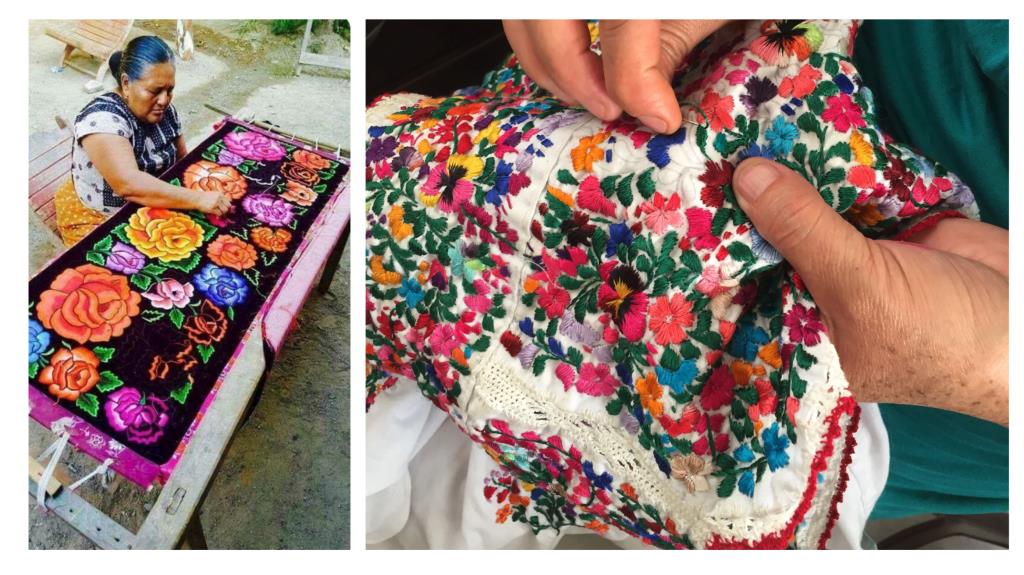
Oaxacan embroidery styles: Tehuana (Istmo de Tehuantepec) embroidery & San Antonino Castillo Velasco embroidery. (Image credit: PieceCollectors – Textiles of Qaxaca)
Oaxacan embroidery dates to pre-Hispanic times, when artisans used agave or maguey thorns as needles. Known for rich, vibrant colors, Oaxacan embroidery it is highly diverse, with each region and Indigenous group in Oaxaca developing distinct styles, motifs, and techniques, deeply rooted in local history and identity. Two of the most popular embroidery styles from the region are:
Tehuana (Istmo de Tehuantepec) Embroidery — famous for bold, colorful floral designs, often worked on velvet or satin using a technique called “gancho” (hook), which creates tightly packed chain stitches. These textiles are closely associated with the iconic Tehuana dress, popularized by artist Frida Kahlo.
San Antonino Castillo Velasco Embroidery —known for intricate floral motifs executed using fine, marked outlines on white cotton poplin. This embroidery style is dense, with a distinct sense of delicacy and precision. Each piece may take up to a week to complete.
Whitework
Altar cloth, unknown, 19th century, Mexico. Bequeathed by Alfred Percival Maudslay. (Image credit: © Victoria and Albert Museum, London)
When Spanish conquistadores reached Mexico in 1519, they were full of praise for the achievements of spinners, dyers, weavers and embroiderers. After the conquest, Spanish needlework skills – including a wide variety of stitches, were widely taught in mission centers. Catholic nuns taught the locals and together they provided their churches with ‘whitework’, an embroidery technique where the stitching is the same color as the foundation fabric, usually white linen, and includes the technique of ‘deshilado’ or drawn threadwork. With deshilado, selected threads are pulled from the ground fabric; the rest are bound and reinforced with decorative stitching.
Shout Out to Other Hispanic & Latino Countries
While this blog primarily highlights the rich textile and embroidery contributions of Mexican culture, both past and present, I also want to acknowledge the remarkable work of other Hispanic and Latino countries. Nations such as Peru, Brazil, Colombia, Guatemala, Chile, and Argentina have each made significant contributions to the world of textiles and embroidery through their distinctive traditions, technical innovations, and sustainable practices.
-------------------------------------
By: Francesca Sterlacci
Title: Threads of Tradition: Honoring Hispanic Heritage Through Textiles & Embroidery
Sourced From: www.universityoffashion.com/blog/threads-of-tradition-honoring-hispanic-heritage-through-textiles-embroidery/
Published Date: Sat, 11 Oct 2025 13:41:01 +0000
Read More
 FestivalsMusicNew ReleasesArtistsFashion & ClothingVideosPrivacy PolicyTerms And Conditions
FestivalsMusicNew ReleasesArtistsFashion & ClothingVideosPrivacy PolicyTerms And Conditions
